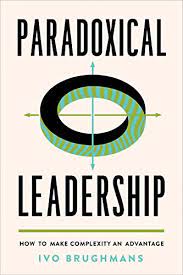Paradoxical leadership
how to make complexity an advantage
- ISBN: 9781487507633
- Editorial: University of Toronto Press
- Fecha de la edición: 2023
- Lugar de la edición: Toronto. Canadá
- Encuadernación: Cartoné
- Medidas: 24 cm
- Nº Pág.: 296
- Idiomas: Inglés

On a daily basis, leaders, managers, and professionals alike have to deal with tensions caused by differing and even opposite approaches. We often feel the need to make a fundamental choice between either one or the other for the sake of clarity. Using practical methodology and an extensive toolkit, Paradoxical Leadership reveals how to transform divisive dilemmas into creative solutions and paralyzing polarization into a constructive dialogue.
Ivo Brughmans focuses on solutions that include both sides of the coin and reconcile conflicting views. He works out the fundamental principles of a paradoxical perspective and explains how to apply them to yourself as a person and a professional, how to integrate them into your leadership style, how to implement them in your team and organization, and how to conduct an effective dialogue on polarizing issues. Developing this paradoxical perspective, the book sheds a refreshingly new light on a wide range of fundamental organizational and management challenges, such as strategy development, business design, corporate governance, performance management, change, agility, innovation, diversity, culture transformation, leadership, and talent.
Demonstrating how to manage contradictions, tensions, and dilemmas in a productive and inclusive way, Paradoxical Leadership provides the skills, frameworks, and tools necessary to integrate both/and thinking into your working and leadership style.
Part 1: In the Lab
1 Polarities and Paradoxes: What Are They and How Do They Work?
1.1 Polarities Are the Lifeblood of Adaptive Systems
1.2 Polarities in Our Minds
1.3 How to Engage with Polarities
1.4 How Polarities Work in Organizations and Social Systems
1.5 Are Polarities Inherent or Socially Constructed
2 The Limitations of Either/Or Thinking
2.1 Various Forms of Either/Or Thinking
2.2 Why Is Either/Or Thinking So Attractive? 2.3 Why Doesn't the Either/Or Approach Work?
2.4 The Challenge
3 Thinking from a Both/And Perspective
3.1 Why Is a Paradigm Shift Necessary and Inevitable?
3.2 The Rise of Paradoxical Leadership and Both/And Thinking
3.3 The Fundamentals of Both/And Thinking
3.4 Principles of Practice
4 How to Balance between Opposite Poles
4.1 Handling Your Own Polarities
4.2 Working with the Polarities of Your Organization
Part 2: At Work
5 Setting the Strategic Direction and Steering the Business
5.1 Strategic Agility
5.2 Specializing while Working Together 5.3 Directing an Organization without Putting It in a Straitjacket
5.4 The Obsession with Measurement and the Limitations of KPIs
6 Change
6.1 Change and Continuity: The Old and the New
6.2 Adaptability, Versatility, and Identity
6.3 Polarization and Tribal Wars
6.4 Paradoxical Interventions: Doing the Opposite to What We Want to Achieve
7 Where People and Organizations Come Together
7.1 The Power of What Is Hidden in the Shadows
7.2 How Diversity Can Help Achieve Better Results
7.3 Creativity and Innovation: A Winding Road
8 Conducting the Paradoxical Dialogue 8.1 The Inner Compass
8.2 How to Shape the Paradoxical Dialogue
8.3 Caught in the Middle: Reconciling Different Worlds
9 Paradoxically Competent
9.1 The Paradoxically Competent Professional and Manager
9.2 The Paradoxical Skill Set
9.3 The Paradoxically Competent Organization
Epilogue: Where Do We Go from Here? Back to the Basics
Appendix A: List of Common Polarities
Appendix B: Paradoxical Organization Scan
Index
About the Author






